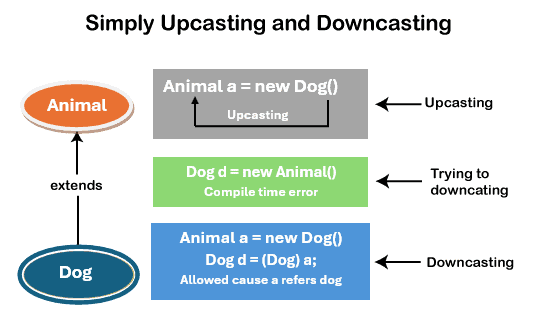1. 简介
掌握Java类型体系中对象的处理方式,是编写灵活可维护代码的关键。其中向上转型(Upcasting)和向下转型(Downcasting)是两个核心概念。本文将深入解析这些概念,对比它们的差异,并通过实际案例演示在Java中的使用场景。
2. Java转型基础
Java作为面向对象语言,允许在类型系统内进行类型转换。转型(Casting)就是将一个类类型的引用转换为另一个类类型的过程。主要分为两种:向上转型和向下转型。
以经典的父子类关系为例:假设Dog是Animal的子类,下图展示了这个层级中的转型机制:
向上转型箭头从Dog指向Animal,表示子类引用可泛化为父类引用;向下转型箭头则相反,从Animal指向Dog,表示父类引用可具体化为子类引用。
⚠️ 注意:直接用Animal引用创建Dog对象会导致编译错误,因为类型不兼容。
3. 向上转型详解
向上转型是将子类引用转换为父类引用的过程。这种转型是隐式的,常用于多态(Polymorphism)场景。它让我们能将子类对象当作父类对象处理:
class Animal {
public void makeSound() {
System.out.println("Animal sound");
}
}
class Dog extends Animal {
public void makeSound() {
System.out.println("Bark");
}
public void fetch() {
System.out.println("Dog fetches");
}
}
这里定义了父类Animal和子类Dog:
Animal有makeSound()方法输出"Animal sound"Dog重写了该方法输出"Bark",并新增了fetch()方法
Animal myDog = new Dog();
myDog.makeSound();
代码中创建Dog实例并赋值给Animal类型变量。调用makeSound()时,实际执行的是Dog类中的重写方法,输出"Bark"。
4. 向下转型实战
向下转型则是将父类引用转换回子类引用。与向上转型不同,它需要显式声明且必须谨慎处理。必须确保被转换对象实际是目标子类类型,否则会抛出ClassCastException。 当需要访问子类特有方法时,就需要向下转型:
Animal myAnimal = new Dog();
Dog myDog2 = (Dog) myAnimal;
myDog2.makeSound();
myDog2.fetch();
操作步骤:
- 先将
Dog对象向上转型为Animal引用 - 再显式向下转型回
Dog引用 - 此时既能调用继承的
makeSound()方法,也能调用子类特有的fetch()方法
通过向下转型,我们重新获得了对子类特有方法和字段的访问权限。
5. 转型对比分析
通过下表清晰对比两种转型的核心特性,帮助理解适用场景:
| 特性 | 向上转型 | 向下转型 |
|---|---|---|
| 定义 | 子类引用 → 父类引用 | 父类引用 → 子类引用 |
| 转型方式 | 隐式(自动) | 显式(强制) |
| 典型场景 | 多态实现中的对象泛化 | 访问子类特有功能 |
| 类型安全 | ✅ 安全,无需类型检查 | ❌ 需类型检查避免ClassCastException |
| 子类方法访问 | ❌ 只能访问父类方法 | ✅ 可访问子类特有方法和字段 |
| 示例场景 | 将Dog对象传给需要Animal参数的方法 |
将Animal引用转回Dog调用其特有方法 |
| 性能影响 | ✅ 高效(无需运行时检查) | ⚠️ 略低(需运行时类型检查) |
6. 总结
向上转型和向下转型是Java类型体系的核心机制,通过继承和多态实现了代码的灵活复用。实际开发中要特别注意:向上转型是安全的常规操作,向下转型则需谨慎验证类型,避免踩坑。
本文配套源码已上传至GitHub仓库,欢迎参考实践。
